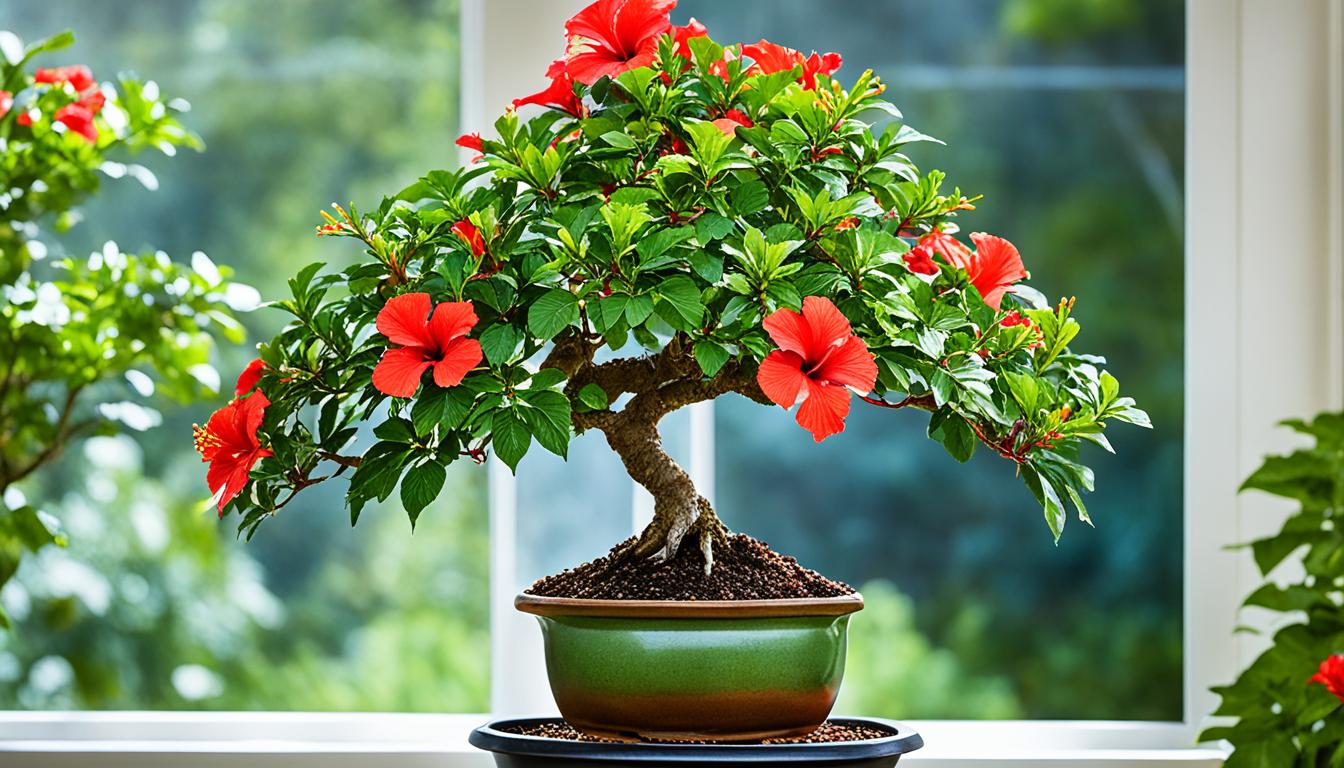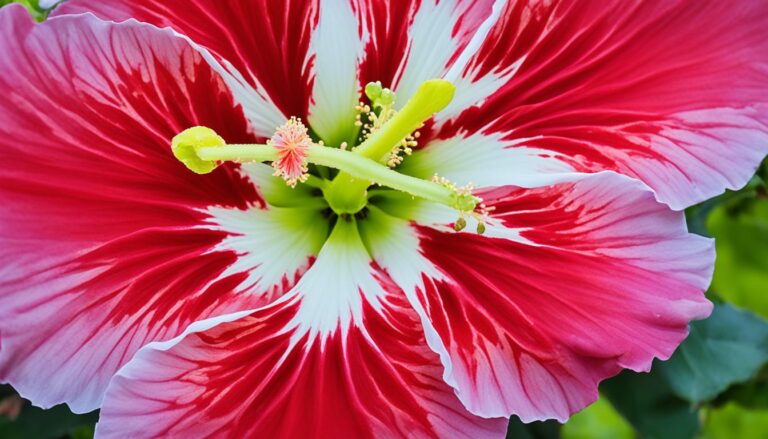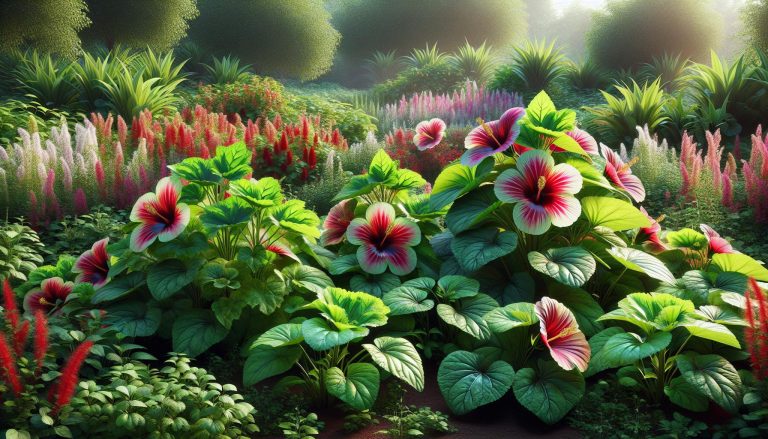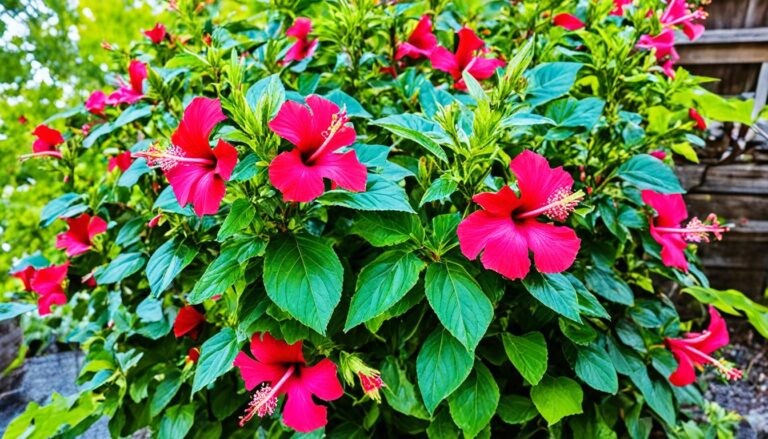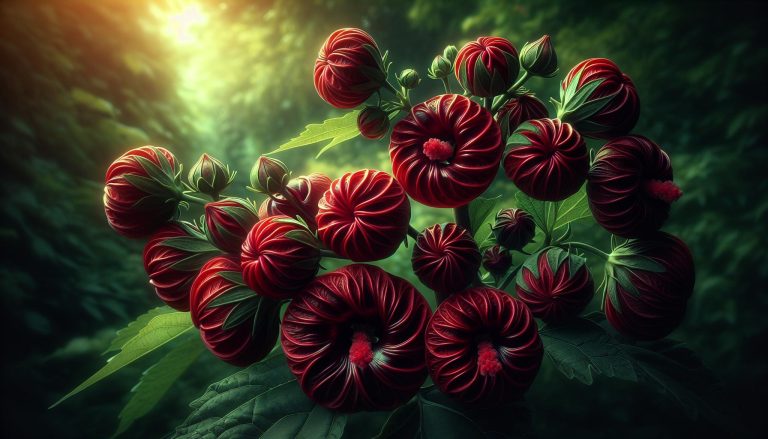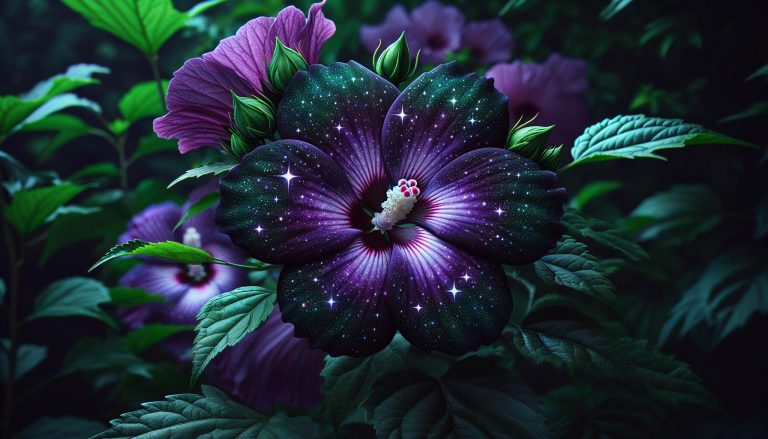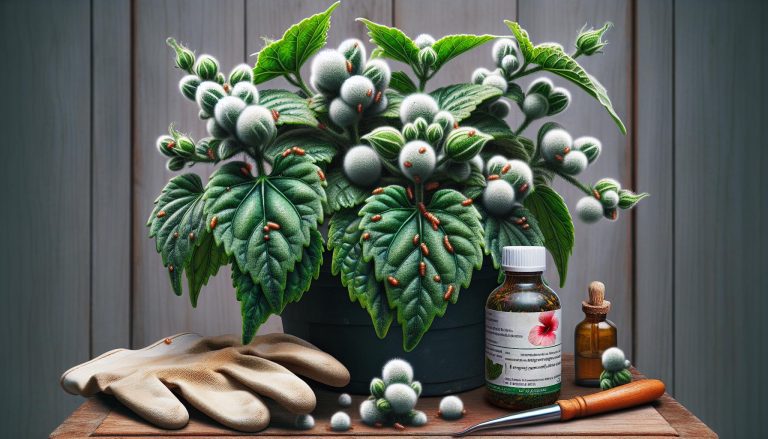Hibiscus Bonsai Care Guide & Tips | Grow Today
Have you ever marveled at the beauty of a hibiscus bonsai tree? The way its delicate branches dance in the wind, adorned with vibrant flowers that seem to hold the sun’s warmth within their petals? It’s a sight that can’t help but stir something deep within us, reminding us of the beauty and magic that nature holds.
As a passionate bonsai enthusiast, I have spent countless hours tending to my hibiscus bonsai trees, carefully nurturing them to reach their full potential. It’s a journey that has taught me patience, perseverance, and the remarkable ability of these miniature trees to capture our hearts.
In this comprehensive care guide, I will share with you the expert tips and techniques I’ve learned over the years. From proper placement and watering to pruning and fertilizing, you’ll discover everything you need to know to create a thriving hibiscus bonsai tree.
So, let’s embark on this horticultural adventure together and unlock the secrets of hibiscus bonsai care.
Key Takeaways:
- Proper care and attention are essential for hibiscus bonsai trees to thrive.
- Expert tips and techniques will guide you in nurturing your hibiscus bonsai.
- From placement and watering to pruning and fertilizing, every step is crucial.
- Uncover the magic and beauty of hibiscus bonsai trees in your own home or garden.
- Join me on this horticultural adventure to unlock the secrets of hibiscus bonsai care.
Placement for Hibiscus Bonsai Trees
Hibiscus bonsai trees require careful consideration when it comes to their placement. By providing the right conditions, you can ensure that your hibiscus bonsai thrives and flourishes. Here are some key points to keep in mind:
Full Sun or Semi-Shade
Hibiscus bonsai trees prefer to be placed in areas with full sun or semi-shade. These tropical beauties love bright light, but they can tolerate some shade if necessary.
Protecting Tropical Species
If you have a tropical hibiscus bonsai, it’s important to protect it from frost. These species are not cold-hardy and should be brought indoors during the winter months. Be sure to place them in a location that receives ample sunlight even indoors. To enhance the overwintering conditions, you can use grow lights to provide the necessary light intensity.
Hibiscus Syriacus Care
Hibiscus syriacus, a hardy species, can tolerate cooler temperatures. However, it should still be protected from strong frost. To safeguard this species, you can keep it in a small bonsai container and bring it indoors when frost is expected. A cold but frost-free greenhouse offers an ideal environment for overwintering Hibiscus syriacus.
By paying attention to proper placement, you can provide your hibiscus bonsai with the right environment for growth and development. Whether you have a tropical species or a hardy hibiscus, ensure that your bonsai tree receives the necessary light and temperature conditions to thrive.
Watering Tips for Hibiscus Bonsai Trees
Proper watering is essential for maintaining the health and vigor of your hibiscus bonsai trees. By following these watering tips, you can ensure that your bonsai receives the right amount of moisture for optimal growth and development.
1. Check the Soil Moisture
Regularly monitor the moisture level of the soil by inserting your finger about an inch deep. If the soil feels dry at this depth, it’s time to water your bonsai. Dry roots can cause dropped flower buds, so it’s important to keep the soil adequately hydrated.
2. Water Thoroughly
When watering your hibiscus bonsai, make sure to thoroughly soak the soil until you see water draining out from the drainage holes at the bottom of the pot. This ensures that the roots receive enough moisture and prevents any dry pockets in the soil.
3. Avoid Overwatering
While it’s important to keep the soil moist, be cautious not to overwater your hibiscus bonsai. Overwatering can lead to root rot and other fungal diseases. Allow the soil to dry out slightly between waterings to maintain a good balance of moisture.
4. Use Neutral Water
Hibiscus bonsai trees prefer to be watered with neutral water, with a pH value between 6.5 and 7.5. This ensures that the bonsai receives the ideal nutrient absorption from the water. Avoid using water with extreme pH levels as it can affect the overall health of your bonsai.
Following these watering tips will help you create a healthy and thriving hibiscus bonsai tree. Keep a regular watering schedule and monitor the soil moisture to ensure optimal care for your bonsai.
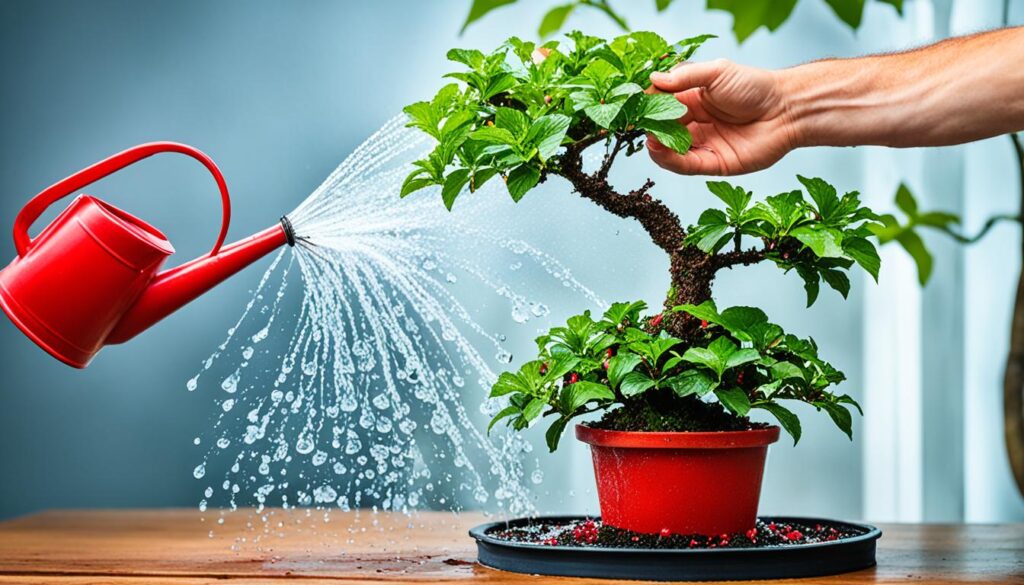
Fertilizing Hibiscus Bonsai Trees
Proper fertilization is crucial for the health and growth of your hibiscus bonsai trees. Providing the right nutrients will not only ensure vibrant blooms but also support overall plant vigor. In this section, we will explore the best fertilization practices for hibiscus bonsai care.
Choosing the right fertilizer
When it comes to fertilizing hibiscus bonsai trees, you have two options: solid organic fertilizer or liquid fertilizer. Solid organic fertilizers, such as compost or slow-release pellets, gradually release nutrients over time. They are typically applied once a month to provide a steady supply of nourishment. On the other hand, liquid fertilizers are quickly absorbed by the roots, providing an immediate nutrient boost. They are generally applied weekly to ensure continuous growth and development. Both types of fertilizer have their advantages, so choose the one that suits your bonsai care routine and preferences.
Fertilizer application
When applying fertilizer to your hibiscus bonsai tree, remember to follow the manufacturer’s instructions for dosage and frequency. Over-fertilization can lead to nutrient imbalances or even burn the roots, so it’s essential to use the right amount. Avoid direct contact between the fertilizer and the plant’s leaves to prevent burning or scorching. Instead, apply the fertilizer to the soil surface, ensuring even distribution around the root zone.
Balanced nutrients for optimal growth
For hibiscus bonsai trees, it’s beneficial to use a balanced fertilizer that provides equal amounts of nitrogen (N), phosphorus (P), and potassium (K). This balanced ratio promotes healthy foliage, robust root development, and abundant flowering. Look for fertilizers labeled with an NPK ratio of around 10-10-10 or similar.
Monitoring and adjusting fertilizer regimen
Regularly monitor the growth and health of your hibiscus bonsai trees to assess their fertilizer needs. Adjust the fertilizer regimen if necessary based on the plant’s response. For instance, if you notice slow growth or pale leaves, it may indicate a nitrogen deficiency. In this case, switch to a fertilizer with a higher nitrogen content. Conversely, if the foliage is lush but blooms are scarce, consider reducing nitrogen levels and increasing phosphorus to encourage flowering.
| Type of Fertilizer | Application Frequency | Recommended Dosage |
|---|---|---|
| Solid Organic Fertilizer | Once a month | Follow manufacturer’s instructions |
| Liquid Fertilizer | Weekly | Follow manufacturer’s instructions |
Summary
Fertilizing hibiscus bonsai trees is a vital aspect of their care. Whether you choose solid organic fertilizer or liquid fertilizer, providing the necessary nutrients will ensure healthy growth, vibrant blooms, and overall plant vigor. Monitor your bonsai’s response to the fertilizer regimen and make adjustments as needed to keep your hibiscus bonsai thriving.
Pruning and Wiring Techniques for Hibiscus Bonsai Trees
Proper pruning and wiring techniques are essential for maintaining the health and aesthetics of your hibiscus bonsai trees. Pruning helps create a well-ramified structure, while wiring allows you to shape and style the branches according to your desired design.
Pruning Techniques
During the early stages of development, hibiscus bonsai trees can be pruned extensively to encourage branching and create a compact shape. Use sharp, clean bonsai shears to remove any unwanted branches or shoots, focusing on maintaining a balanced canopy. This will help distribute energy evenly throughout the tree.
For mature hibiscus bonsai trees, pruning is done differently. It is recommended to shorten new shoots to one or two leaves during the growing season. This technique promotes blooming and encourages the tree to focus its energy on producing vibrant flowers.
Wiring Techniques
Wiring is a common technique in bonsai cultivation that allows you to bend and position branches to create the desired shape and style. When wiring hibiscus bonsai trees, it is important to exercise caution as their branches are fragile.
Start by selecting a high-quality bonsai wire that is appropriate for the thickness of the branch you intend to wire. Gently wrap the wire around the branch, making sure not to bend it too tightly or cause damage. The wire should be snug but not overly tight.
Avoid leaving the wire on for too long as it may cause indentations or scars on the branches. Regularly monitor the growth of the branches and remove the wire once it has served its purpose.
Shaping and Styling
Shaping and styling your hibiscus bonsai tree is a creative process that allows you to bring out its unique beauty. Use pruning and wiring techniques to guide the growth of the branches and create the desired shape. You can explore different styles such as formal upright, informal upright, cascade, or windswept.
Remember to consider the natural growth pattern of the tree and aim for a harmonious balance between its trunk, branches, and foliage. Regularly trim and maintain the tree’s shape to ensure it remains visually appealing over time.
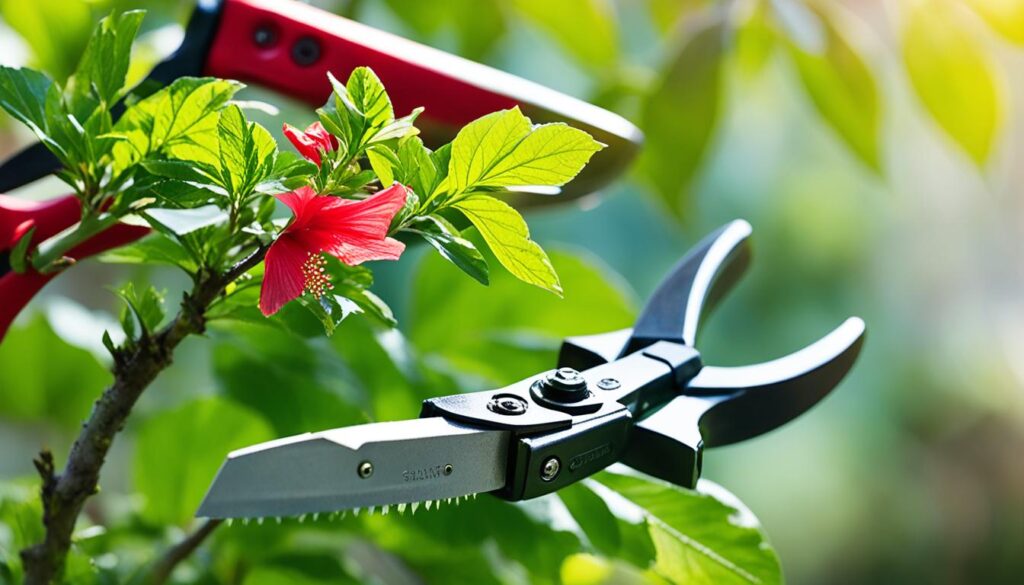
Repotting Hibiscus Bonsai Trees
Repotting is an essential part of hibiscus bonsai care. It allows the tree to receive fresh nutrients and promotes healthy growth. Follow these guidelines to successfully repot your hibiscus bonsai:
- Frequency: Repot hibiscus bonsai trees every two to three years. Younger trees may require more frequent repotting, while older trees can be repotted less often.
- Timing: Summer is the best time to repot hibiscus bonsai trees when they are actively growing.
- Soil Mixture: Use a standard soil mixture suitable for hibiscus bonsai. A well-draining mixture with a balance of organic materials and inorganic components, such as akadama, lava rock, and pumice, works well. Older trees may benefit from a higher ratio of akadama in the soil mixture.
- Root Pruning: Before repotting, carefully prune the roots to remove any diseased, damaged, or circling roots. Root pruning stimulates new root growth and helps maintain the tree’s health.
Proper repotting ensures that your hibiscus bonsai tree has enough space for its roots to grow, allowing it to continue thriving and flourishing.
Steps to Repotting a Hibiscus Bonsai Tree
| Step | Description |
|---|---|
| 1 | Prepare the new bonsai pot |
| 2 | Prune the roots |
| 3 | Remove the tree from its current pot |
| 4 | Inspect the root system |
| 5 | Trim any damaged or circling roots |
| 6 | Place the tree in the new pot |
| 7 | Add the soil mixture |
| 8 | Water the tree thoroughly |
| 9 | Place the repotted tree in a shaded area |
Repotting your hibiscus bonsai at the right time using the proper techniques will ensure the continued health and beauty of your miniature tree.
Propagation of Hibiscus Bonsai Trees
One of the most rewarding aspects of hibiscus bonsai care is propagating new trees. There are several methods you can use to propagate hibiscus bonsai trees, including seed propagation, cutting propagation, and air-layering.
Seed Propagation
Seed propagation is a popular method for growing hibiscus bonsai trees. It can be done in the spring when the temperatures are mild. Start by soaking the seeds in water for 24 hours to soften the coat and improve germination. Plant the seeds in a well-draining potting mix and keep the soil consistently moist. Germination usually takes around two to three weeks. Once the seedlings have grown large enough, they can be transplanted into individual bonsai pots.
Cutting Propagation
Cutting propagation is another effective method for propagating hibiscus bonsai. Take cuttings from the parent tree in the summer when the plant is actively growing. Choose healthy, non-flowering branches and make a clean cut just below a leaf node. Remove the lower leaves, leaving two or three pairs of leaves at the top. Dip the cut end in rooting hormone and plant the cutting in a well-draining potting mix. Keep the soil moist and place the cutting in a warm and humid environment. Rooting usually occurs within four to six weeks.
Air-Layering
Air-layering is a more advanced propagation technique that involves creating a new root system on a branch while it is still attached to the parent tree. This method is usually performed in the spring or early summer. Select a healthy branch and make a vertical cut about halfway through the branch. Apply rooting hormone to the cut area and wrap it with moist sphagnum moss. Cover the moss with plastic wrap to create a humid environment. After a few weeks, roots will form in the moss. Once the roots are well-developed, the branch can be cut below the air-layer and potted as a new hibiscus bonsai.
Experiment with different propagation methods to find the one that works best for you. Each method has its advantages and challenges, so don’t be afraid to try them all. Enjoy the satisfaction of growing new hibiscus bonsai trees and expanding your collection.
Common Pests and Diseases of Hibiscus Bonsai Trees
Hibiscus bonsai trees are generally resistant to pests and diseases. However, it’s important to be aware of common issues that can arise in order to keep your bonsai healthy and thriving.
Chlorosis: A Potential Concern
One common condition that can affect hibiscus bonsai trees is chlorosis. Chlorosis occurs when the leaves of the plant turn yellow, indicating a lack of chlorophyll production. This condition is often caused by nutrient deficiencies, specifically an iron deficiency.
If you notice yellowing leaves on your hibiscus bonsai tree, particularly between the veins, it may be a sign of chlorosis. This can occur if the bonsai is not receiving an adequate supply of iron.
Treating Chlorosis with Ferric Fertilizer
To treat chlorosis in your hibiscus bonsai tree, it is important to provide it with a ferric fertilizer. Ferric fertilizer contains iron, which is essential for healthy chlorophyll production and green foliage.
When applying ferric fertilizer to your hibiscus bonsai, follow the package instructions for the proper dosage. Be sure to evenly distribute the fertilizer around the root system, taking care not to over-fertilize, as this can lead to other nutrient imbalances.
Regular applications of ferric fertilizer will help correct chlorosis and promote healthy growth in your hibiscus bonsai tree.
| Pests | Diseases |
|---|---|
|
|
General Information about Hibiscus Bonsai Trees
When it comes to hibiscus bonsai trees, there is a diverse range of features that make them truly captivating. Whether it’s their leaves, bark, or magnificent flowers, these miniature trees are a sight to behold.
Leaves
The leaves of hibiscus bonsai trees can come in different forms. Some varieties have dark green leaves that are toothed or lobed, adding an intriguing texture to the overall appearance. Tropical species boast glossy leaves, whereas temperate species have a more matte surface, creating a distinct contrast.
Bark
The bark of hibiscus bonsai trees starts off as a light beige color and gradually matures into a beautiful shade of grey. Over time, the bark becomes rough, adding a natural and weathered feel to the tree. This aging process adds character and allure to the overall bonsai aesthetic.
Flowers
One of the most captivating features of hibiscus bonsai trees is their stunning flowers. These trees produce showy blossoms with trumpet-like shapes and multiple petals. The flower colors range from vibrant red, white, yellow, orange, pink, purple, to even blue, creating a magnificent burst of color in any bonsai collection.
Different Species and Sizes
When it comes to hibiscus bonsai trees, there is a wide variety of species to choose from. Hibiscus syriacus, also known as Rose of Sharon, is a frost-hardy species that is suitable for creating smaller bonsai trees. On the other hand, Hibiscus rosa-sinensis is often used for medium-sized bonsai, showcasing its versatility in bonsai cultivation.
| Species | Suitable for Bonsai |
|---|---|
| Hibiscus syriacus (Rose of Sharon) | Smaller bonsai trees |
| Hibiscus rosa-sinensis (Chinese Hibiscus) | Medium-sized bonsai trees |
Add a touch of elegance and natural beauty to your bonsai collection with hibiscus bonsai trees. Their unique leaves, distinctive bark, and breathtaking flowers make them truly remarkable additions to any space.
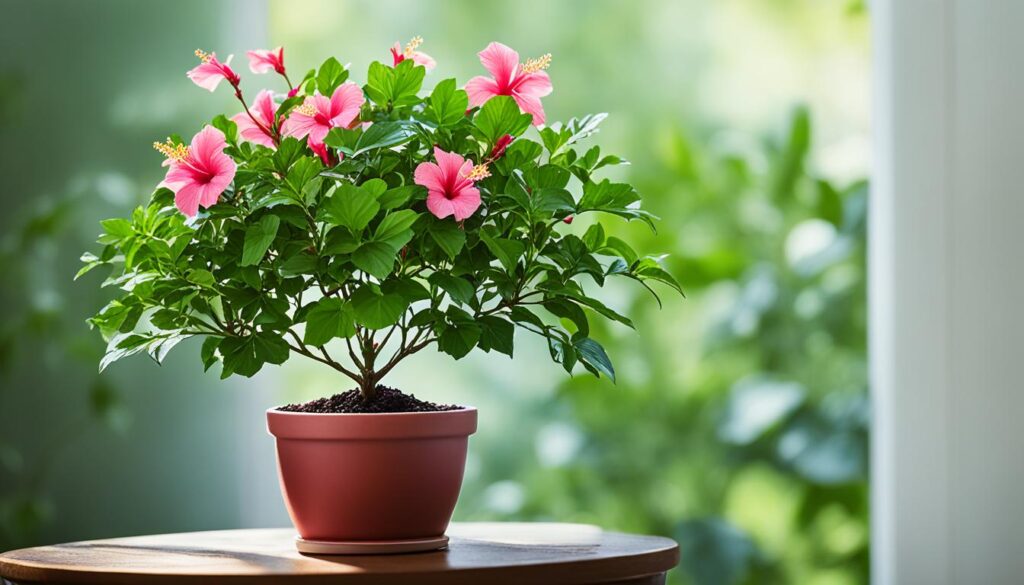
Why Hibiscus Makes a Good Bonsai
Hibiscus bonsai trees are an excellent choice for bonsai enthusiasts due to their unique characteristics and stunning visual appeal. They possess small, shiny leaves that are ideal for shaping, allowing for intricate and artistic designs to be created.
One of the standout features of hibiscus bonsai trees is their ability to produce abundant and beautiful flowers. These vibrant blooms come in a wide range of colors, including red, white, yellow, orange, pink, purple, and even blue, adding a splash of color to any space.
With proper care, hibiscus bonsai trees are relatively easy to maintain, making them suitable for bonsai enthusiasts of all skill levels. By following the principles of miniature tree care, such as proper watering, fertilization, pruning, and repotting techniques, you can ensure the health and vitality of your hibiscus bonsai.
To summarize, hibiscus bonsai trees are an excellent choice for bonsai enthusiasts due to their small, shiny leaves that are perfect for shaping, their abundant and beautiful flowers, and their relatively easy maintenance requirements. With their unique charm and visual appeal, hibiscus bonsai trees are sure to enhance any bonsai collection.
How To Bonsai a Hibiscus
When bonsai-ing a hibiscus, it is important to choose a variety that is suitable for your climate and environment. Hibiscus bonsai trees thrive in warm, sunny conditions, so if you are growing them indoors, ensure they are placed in a spot with plenty of sunlight. Alternatively, you can supplement the natural light with grow lights to ensure they receive adequate illumination.
Regular pruning and pinching back of new growth is essential to maintain a compact shape for your hibiscus bonsai tree. By removing excess branches and encouraging a denser canopy, you can enhance the overall appearance of your bonsai.
Watering is a crucial aspect of hibiscus bonsai care. It is important to water deeply, allowing the soil to become completely saturated. However, it is equally important to allow the soil to dry out between waterings to prevent root rot. Finding the right balance is key to ensuring the health and vitality of your hibiscus bonsai tree.
Fertilizing your hibiscus bonsai regularly with a balanced bonsai fertilizer will provide the essential nutrients required for healthy growth and vibrant blooms. Be sure to follow the manufacturer’s instructions for application rates and frequency.
Summary: How to Bonsai a Hibiscus
To successfully bonsai a hibiscus, follow these key steps:
- Choose a variety suitable for your climate and environment.
- Place indoor hibiscus bonsai trees in a sunny spot or supplement with grow lights.
- Prune and pinch back new growth regularly to maintain a compact shape.
- Water deeply, allowing the soil to dry out between waterings.
- Fertilize regularly with a balanced bonsai fertilizer.
By following these guidelines, you can enjoy the beauty of a well-maintained hibiscus bonsai tree and create a stunning centerpiece for your home or garden.
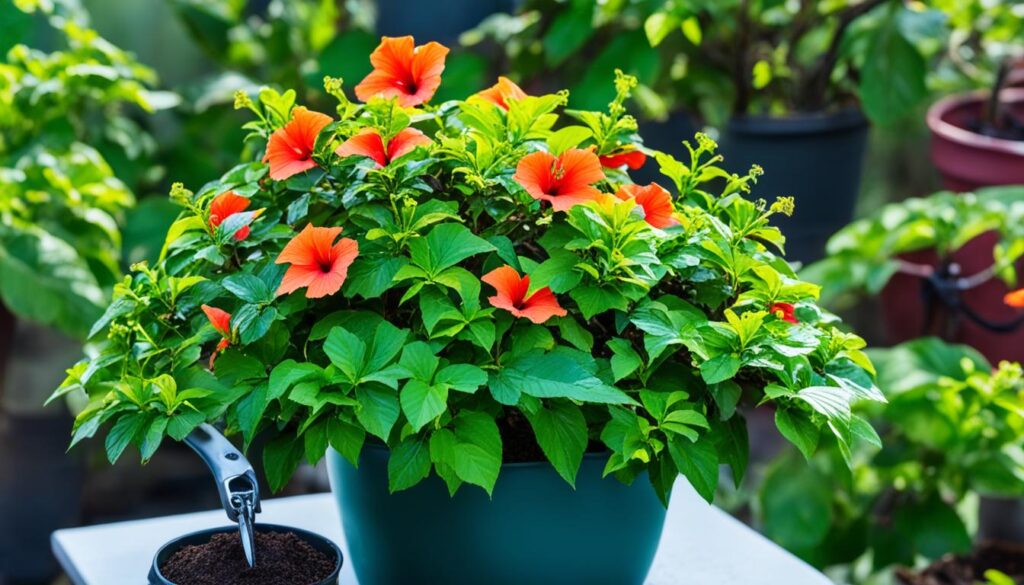
Selecting a Hibiscus Bonsai Tree
When it comes to choosing a hibiscus bonsai tree, several factors should be taken into consideration to ensure its optimal growth and development. Consider the size, climate, and sunlight requirements when making your selection to ensure that the tree fits your space and can thrive in your specific environment.
Size: Hibiscus bonsai trees come in various sizes, ranging from small to medium. Before purchasing a bonsai tree, assess the available space where you intend to keep it. Consider whether you prefer a compact miniature tree that can be displayed indoors or a larger tree suitable for outdoor spaces.
Climate: Hibiscus trees have specific climate preferences. Some varieties thrive in tropical or subtropical regions, while others can withstand colder temperatures. Determine your climate zone and choose a hibiscus bonsai tree that is well-suited to your local weather conditions.
Sunlight Requirements: Hibiscus trees require ample sunlight to thrive and produce vibrant blooms. Ensure that your chosen bonsai tree receives at least six hours of direct sunlight per day. If you plan to keep it indoors, select a location where it can receive sufficient sunlight or supplement with grow lights.
Characteristics to Consider When Selecting a Hibiscus Bonsai Tree
| Factors | Considerations |
|---|---|
| Size | Choose a size suitable for your available space |
| Climate | Select a variety that thrives in your specific climate zone |
| Sunlight Requirements | Ensure the tree will receive at least six hours of direct sunlight per day |
By carefully considering these factors, you can select a hibiscus bonsai tree that will flourish in your environment and bring beauty to your home or garden.
Dwarf Hibiscus as a Bonsai Tree
Dwarf Hibiscus, also known as Hibiscus rosa-sinensis, is a popular choice for bonsai. It is easy to care for and has beautiful flowers. Native to Asia, it can be grown outdoors in USDA hardiness zones 9-11 or as a houseplant in cooler climates.
To successfully grow a dwarf hibiscus bonsai, here are some care tips:
1. Placement:
Dwarf hibiscus bonsai trees thrive in full sunlight, so place your tree in a spot that receives at least six hours of direct sunlight per day. If growing indoors, supplement with artificial grow lights to provide the necessary light intensity.
2. Watering:
Water your dwarf hibiscus bonsai regularly to keep the soil consistently moist but not waterlogged. During hot summer months, you may need to water more frequently. Ensure proper drainage to prevent waterlogging and root rot.
3. Fertilizing:
Feed your dwarf hibiscus bonsai with a balanced liquid fertilizer every two weeks during the growing season (spring and summer). This will provide the necessary nutrients for healthy growth and abundant flowering.
4. Pruning:
Regular pruning helps maintain the desired shape and size of your dwarf hibiscus bonsai. Trim back overgrown branches and remove any dead or diseased parts. Pruning should be done after blooming to encourage new growth.
5. Repotting:
Repot your dwarf hibiscus bonsai every two to three years, preferably in early spring. Use a well-draining bonsai soil mix and trim the roots to maintain a healthy root system.
6. Pests and Diseases:
Monitor your dwarf hibiscus bonsai for common pests such as aphids, whiteflies, and spider mites. Treat any infestations promptly with appropriate insecticides. Proper care and maintenance will help prevent diseases such as powdery mildew and root rot.
By following these care tips, you can enjoy the beauty of a dwarf hibiscus bonsai in your home or garden. Its vibrant flowers and compact size make it a delightful addition to any bonsai collection.
Hibiscus Bonsai Varieties:
| Variety | Scientific Name | Flower Colors |
|---|---|---|
| 1. Dwarf Hibiscus | Hibiscus rosa-sinensis | Various colors including red, white, yellow, orange, pink, and purple |
| 2. Hibiscus Syriacus | Hibiscus syriacus | Purple, pink, or white |
| 3. Hibiscus Sinensis | Hibiscus sinensis | Various colors including red, orange, pink, and yellow |
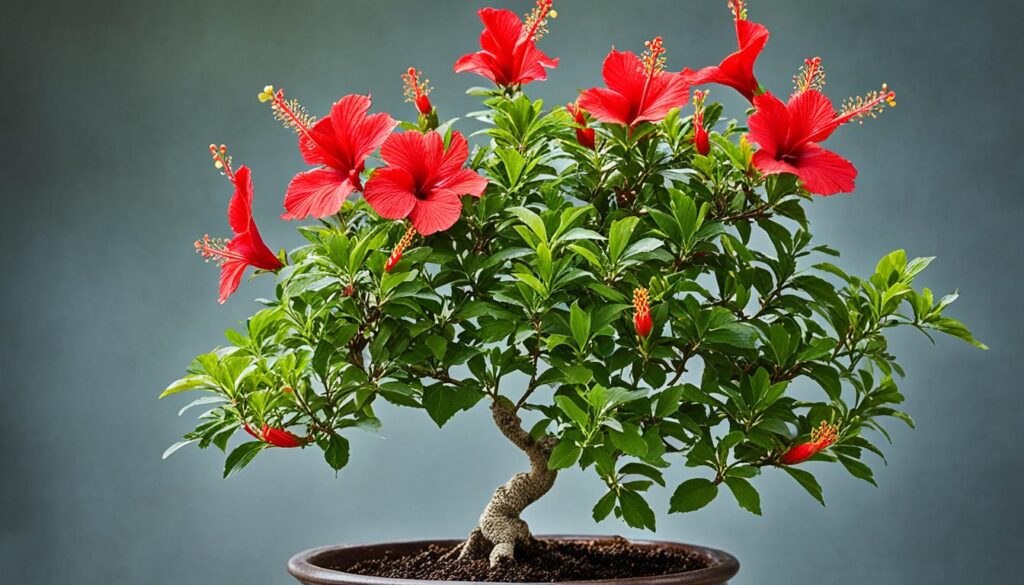
Additional Care Tips:
- Pay attention to temperature and humidity levels, as dwarf hibiscus bonsai trees prefer warm and humid conditions.
- Regularly check for pests and diseases, taking appropriate measures for prevention and treatment.
- Provide good air circulation around the tree to prevent fungal infections.
- Be patient with your bonsai’s growth and enjoy the process of shaping it over time.
With proper care, your dwarf hibiscus bonsai will reward you with its stunning flowers and serve as a beautiful centerpiece for your bonsai collection.
Hibiscus Syriacum (Rose of Sharon or Purple Hibiscus)
Hibiscus Syriacum, also known as Rose of Sharon, is a stunning choice for bonsai trees. This deciduous tree is native to Asia and features large, showy flowers in purple, pink, or white. With its vibrant blooms, Hibiscus Syriacum can be a striking centerpiece in any bonsai collection.
When caring for your Hibiscus Syriacum bonsai, it is essential to provide it with adequate sunlight, regular watering, and proper fertilization. This particular species thrives best in bright, indirect light and requires moist, well-draining soil. To maintain its overall health and promote blooming, consider using a balanced bonsai fertilizer according to the manufacturer’s instructions.
Pruning is an important aspect of maintaining the desired shape and structure of your Hibiscus Syriacum bonsai. Regularly inspect the tree for any dead or dying branches and remove them to encourage new growth. Additionally, pinching back new growth can help maintain a compact form.
Overall, Hibiscus Syriacum bonsai requires consistent care and attention. By following these care tips, you can enjoy the beauty of this colorful species and create a visually captivating bonsai tree.
Hibiscus Sinensis (Chinese Hibiscus)
Hibiscus Sinensis, originally from China, is widely cultivated in tropical and subtropical regions. It is a popular choice for bonsai due to its attractive flowers and small leaves. It thrives in bright sunlight and regular watering.
With its vibrant blooms and compact size, the Hibiscus Sinensis is a stunning addition to any bonsai collection. Its flowers come in a variety of colors, including shades of red, pink, white, orange, and yellow, adding a beautiful pop of color to your space.
To ensure the health and vitality of your Hibiscus Sinensis bonsai, it is important to provide it with bright sunlight. Place your bonsai in a location where it can receive at least six hours of direct sunlight each day. This will help the tree to grow and flower abundantly.
In addition to sunlight, regular watering is essential for the proper care of Hibiscus Sinensis bonsai. The soil should be kept evenly moist, but not waterlogged. Water the tree thoroughly when the top inch of soil feels dry to the touch. Avoid overwatering, as this can lead to root rot and other issues.
Varieties of Hibiscus Sinensis Bonsai
There are several popular varieties of Hibiscus Sinensis that are commonly used for bonsai:
| Variety | Flower Color |
|---|---|
| Orange Peel | Orange |
| Peach Blow | Pink |
| Sunset Yellow | Yellow |
Each variety has its own unique characteristics and flower color, allowing for a diverse and visually appealing bonsai collection.
In conclusion, the Hibiscus Sinensis is a stunning bonsai tree that captivates with its beautiful flowers and small leaves. With bright sunlight and regular watering, you can ensure the health and vitality of your Hibiscus Sinensis bonsai, enjoying its vibrant colors and graceful presence in your home or garden.
Conclusion
Congratulations on completing this comprehensive hibiscus bonsai care guide! By following the tips and techniques outlined in this article, you now have the knowledge and tools to successfully nurture your hibiscus bonsai trees.
Remember to provide proper placement, ensuring your bonsai tree receives the right amount of sunlight and protection from frost. When it comes to watering, maintain a regular schedule while avoiding overwatering. Fertilize your hibiscus bonsai regularly to promote healthy growth and vibrant blooms. Pruning and repotting should be done with care, taking into consideration the specific needs of your bonsai tree.
Propagation methods and strategies to combat common pests and diseases have also been explored in this guide. With these tips and your dedication, you can create a breathtaking miniature tree and experience the joy of hibiscus bonsai in your home or garden.

